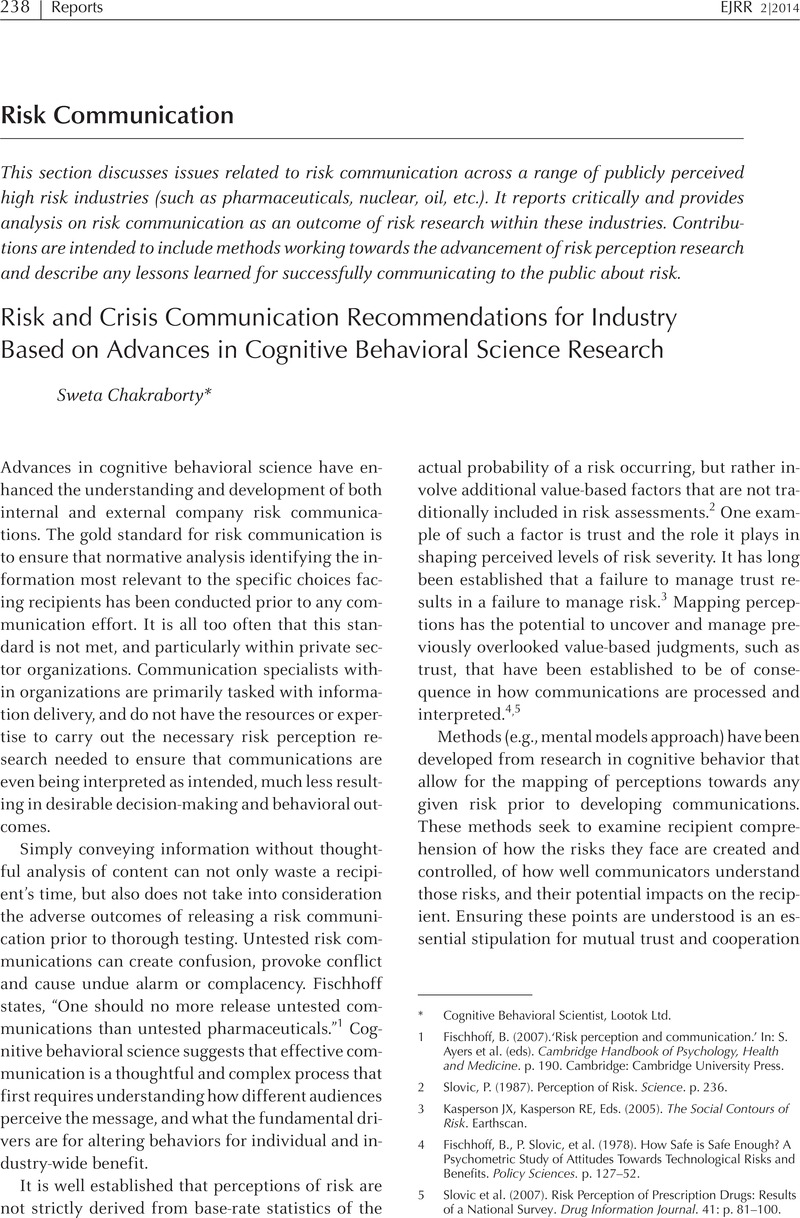Published online by Cambridge University Press: 20 January 2017

1 Fischhoff, B. (2007).‘Risk perception and communication.’ In: Ayers, S. et al. (eds). Cambridge Handbook of Psychology, Health and Medicine. p. 190. Cambridge: Cambridge University Press.Google Scholar
2 Slovic, P. (1987). Perception of Risk. Science. p. 236.Google ScholarPubMed
3 Kasperson, JX, Kasperson, RE, Eds. (2005). The Social Contours of Risk. Earthscan.Google Scholar
4 Fischhoff, B., Slovic, P., et al. (1978). How Safe is Safe Enough? A Psychometric Study of Attitudes Towards Technological Risks and Benefits. Policy Sciences. p. 127–52.CrossRefGoogle Scholar
5 Slovic, et al. (2007). Risk Perception of Prescription Drugs: Results of a National Survey. Drug Information Journal. 41: p. 81–100.CrossRefGoogle Scholar
6 Fischhoff, B. (1995). Risk Perception and Communication Unplugged: Twenty Years of Process. Risk Analysis. p. 137–45.CrossRefGoogle Scholar
7 Sandman, P. (2005). Terrorism and Other Public Health Emergencies: A Reference Guide for the Media. Washington, DC: U.S. Department of Health & Human Services. Chapter 11: p. 184–193.Google Scholar
8 Morgan, G. M., Fischhoff, B, Bostrom, A, Atman, C J. (2002). Risk Communication: A Mental Models Approach. Cambridge University Press.Google Scholar
9 Ibid.
10 Conzelmann, T. (2007). External Transparency and Internal Viability. Paper presented at the annual meeting of the International Studies Association 48th Annual Convention ; Hilton Chicago: Chicago, IL.Google Scholar
11 Chakraborty, S, Lofstedt, R. (2012). Transparency Initiative by the FDA's Center for Drug Evaluation and Research (CDER): Two qualitative studies of Public Perceptions. EJRR. 3(1): p. 57–71.Google Scholar
12 Fung, A, Graham, M, Weil, D. (2007). Full Disclosure: The perils and promise of transparency. Cambridge: Cambridge University Press.CrossRefGoogle Scholar
13 Chakraborty, S. (2012a). Part 1: The Role of Trust in Patient Non-Compliance: A Qualitative Case Study of Users of Statins for the Chronic Treatment of High-Cholesterol in New York City. Journal for Risk Research. 16(1): p. 97–112.CrossRefGoogle Scholar
14 Chakraborty, S. (2012b). Part 2: The Role of Trust in Patient Non-Compliance: A Quantitative Case Study of Users of Statins for the Chronic Treatment of High-Cholesterol in New York City. Journal for Risk Research. 16(1): p. 113–29.CrossRefGoogle Scholar
15 Hilts, PJ. (2003). Protecting America's Health: The FDA, Business, and One Hundred Years of Regulation. New York, Knopf.Google Scholar
16 Bradford, JL, Garrett, DE. (1995). The effectiveness of corporate communicative responses to accusations of unethical behaviour. Journal of Business Ethics. 14(11): p. 875–92.CrossRefGoogle Scholar
17 Lofstedt, R. (2007). The Impact of the Cox-2 Inhibitor Issue on Perceptions of the Pharmaceutical Industry: Content Analysis and Communication Implications. J Health Commun. 12(5): p. 471–91.CrossRefGoogle Scholar
18 US Food and Drug Administration. (2004). FDA Acts to strengthen the safety program for marketed drugs. FDA Statement. Rockville: FDA.Google Scholar
19 Löfstedt, R. (2005). Risk Management in Post Trust Societies. Basingstoke, Palgrave/Macmillan.CrossRefGoogle Scholar
20 Chakraborty, S and Bouder, F. (2013). The Future of Risk Communication and the Role of the Pharmaceutical Industry. Drug Safety. 8(1): p. 4–10.CrossRefGoogle ScholarPubMed